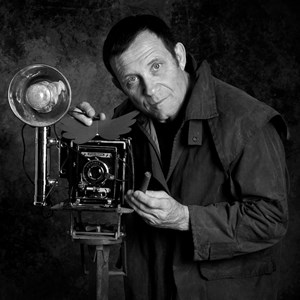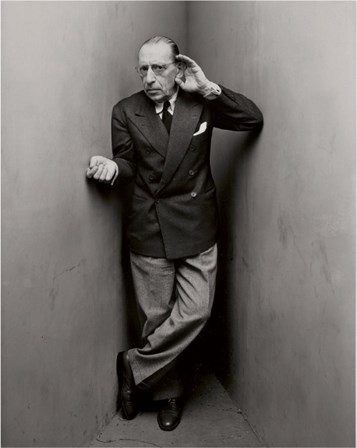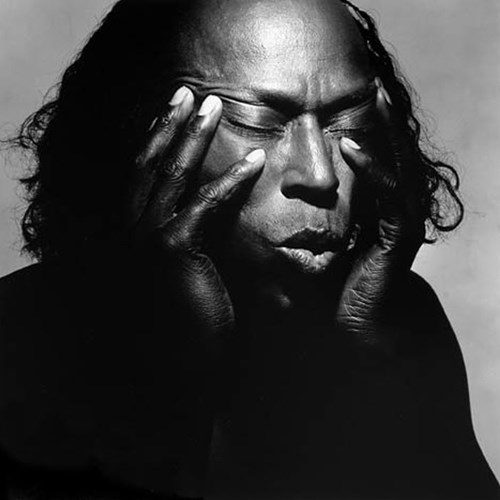Over the coming months, I’m going to select a number of images taken by famous photographers that feature key portraits of the 20th century. Portraiture, whether taken in the studio or by natural light has always been a passion of mine. Images that show something about the subject, how the photographer can penetrate through the façade that we all show when our picture's taken. We still use that phrase don’t we; ‘take a picture’, meaning that we take something from our subject, making a portrait sitting an intimidating process - something I know only too well sitting in front of studio lights!
It’s this process I want to explore in the work of different photographers and their approach to portraiture. My first featured photographer is Irving Penn, the American photographer, whom I believe was instrumental in the way we take portraits today. He was one of the first photographers to shoot his subjects against a neutral background in the studio, rather than setting them with props that showed something about their profession or career, a more favoured method of portraiture in the first half of the twentieth century. I admire Penn’s portrait work because of his ability to convey something about his subject, his ability to bridge the gap between the photographer and the sitter and his ability to create stunning compositions that have stood the test of time.
 Irving Penn
Irving PennHis portrait career spanned nearly seven decades and he is also famous for his work in, fashion photography and still life. It’s not easy to sum up the importance of Penn in just a few words as he shot virtually non-stop from 1944 until his death in 2009 producing an enormous body of work and books. I think that he’ll best be remembered for his work shot for Vogue magazine, and his portraiture, photographing painters, actors and dancers in the sparse style that he made his own.
Irving Penn was born in 1917, in New Jersey and is the elder brother of film director Arthur Penn who sadly died last year. He attended the Pennsylvania Museum School of Industrial Art in Philadelphia (now the University of the Arts) from 1934 to 1938 where he studied painting, graphic and industrial design. It was here that he studied under the famous Russian painter Alexey Brodovitch, who was also a photographer and graphic designer working at Harper’s Bazaar.
It was Brodovitch who spotted Penn’s talent and invited Penn to New York to work unpaid in his summer holidays for Harpers Bazaar. When he completed his education, he moved to New York to become a freelance designer for Harpers. He began working at Saks on Fifth Avenue as director of advertising, but left to become a painter in Mexico, returning to New York in 1943. He was offered a job as assistant art director at Vogue magazine, remaining at Vogue until he set up his own studio in 1953.
When we take portraits today, we think it only natural to shoot subjects against a white, grey or black background. However, Irving Penn was one of the first photographers to adopt this style, rather than shooting his subjects in the more elaborate studio settings more favoured at the time. It was in 47 and 48 that Penn shot a whole series of images that broke the conventional mould of studio portraiture forever. He photographed his subjects sandwiched between two angled boards that formed a ‘V’ shape that naturally leads the eye towards them as the perspective narrowed. He also shot his subjects sitting on bare carpet in an empty studio, often arranged at odd angles and positions. This method was totally new and broke all the conventions of studio portraiture, it was a brand new way of photographing people without props and one that we take very much for granted now.
 Igor Stravinsky by Irving Penn
Igor Stravinsky by Irving PennThis earlier work of Penn, using the confines of this rather bleak studio setting, is in contrast to his later work, where he mainly shot head and shoulders portraiture, getting in really close and creating some of the finest portraits ever taken in my opinion. It’s the later style of Penn’s portraiture that I admire most, all beautifully composed and cropped. Just because Penn photographed ‘famous’ people didn’t mean his images were an automatic success. Looking at his portraits, it seems to me that he never stopped trying to achieve perfection.
To achieve that perfection, Penn also taught himself long forgotten darkroom techniques and processes to enhance his work. The processes included applying platinum rather than silver on the printing paper that produced wonderfully smooth and more permanent, long lasting tones. After he had perfected this difficult process, he began to reprint a lot of his earlier work, producing prints of amazing depth and luminosity. I’ve seen Penn’s work at exhibitions and you certainly notice those qualities, especially the different tones within each print when you view the images close up, they look like paintings and I would love to own one! I could go on and on, but I hope that I’ve managed to convey some of my enthusiasm for Penn’s work.
 Miles Davis by Irving Penn
Miles Davis by Irving PennThe portrait that I’ve chosen to talk about is a photograph of another hero of mine, the jazz musician Miles Davis. It’s one of Penn’s later close-cropped portraits of Miles taken with his eyes closed and his hands on his face. You can see Miles thinking and maybe humming or whistling a tune - it’s a great portrait. The light falls perfectly on his hands and face and I like the crop too, losing the top part of the subject’s head and fading into black at the bottom, focusing all the attention onto Miles’ face.
“In portrait photography there is something more profound that we seek inside a person, while being painfully aware that a limitation of our medium is that the inside is recordable only insofar as it apparent on the outside.”
Irving Penn.
The shot of Miles Davis epitomizes Penn’s skill as a photographer to find that “more profound” side of his subject. Penn shot Miles Davis several times and another favourite image of Miles’ is a shot just of his hand taken against a neutral background. It shows his hand open with one finger down, as if playing a note on his trumpet. It’s unmistakably Miles and a very clever piece of work indeed I hope you find the time to look at that, and more of Irving Penn’s work. If you type in his name into any search site, you’ll have no difficulty in finding other great portraits to look at. Look out for Issy Miyake, Duke Ellington and Pablo Picasso, other favourites of mine. I’m always interested in your views, so please let me know what you think about Irving Penn’s portraiture, especially if you haven’t seen them before.

